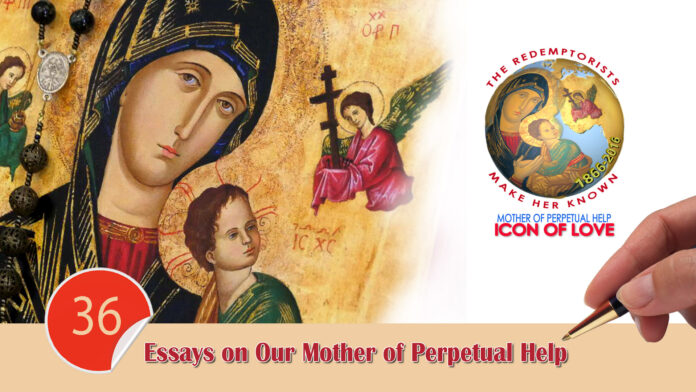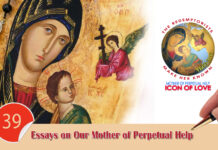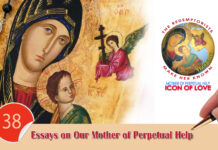During this jubilee year of our icon of Perpetual Help, I would like to offer the suggestion of the necessity of contemplating its message and spreading this message to the people who come to Mary for her Perpetual Help.
I was born in a Redemptorist parish in Brooklyn, New York and since childhood, Mom and Dad celebrated every Wednesday the novena to Perpetual Help bringing their six children with them. But it was a mystery to me why they called Mary Mother of Perpetual Help. Only many years later as a Redemptorist, did I sit down in prayer to contemplate her icon. In this article,, I would like to share with you my contemplation.
1 – Perpetual Help is an icon and not a work of art like in the Western Church that emphasizes light and contrast. It has as its background a rich Byzantine Marian theology. An icon is described as a “window” into God’s presence and His plentiful redemption. An icon is first of all an encounter with God. An icon is to be prayed for and not a simple appreciation of its artistic values.
2 – The artist most likely was a monk in the Byzantine rite. A monk usually prayed for a long time on the theme he wished to paint, normally on wood, before he even touched the paintbrush. An icon is an invitation to contemplate the painting in order to draw out of it the theological and spiritual messages that the monk hid inside his painting. Each detail therefore is important because it is a “window” into God’s heart and will to save all humankind.
3 – The themes that the Byzantine monks used were identified by categories. It could be about the Saviour, angels, Mary, Saints and the principal themes of salvation History. Our icon falls into the “Passion” category. Seems strange, but we will understand why, with the explanation of the icon.
4 – Let’s begin our contemplation. There are four figures in our icon. The Archangels Michael (on the right) and Gabriel (on the left) are identified by their initials in Greek above their heads. In the centre of the icon, we have Mary as a Mother. And finally, there is Jesus represented as a child (both identified by Greek initials above or on their side).
5 – According to the artist and his imagination Jesus like any child was outside playing when all of a sudden he had a vision. And this vision left him profoundly perturbed and with great fear. And like any child in this situation, he ran quickly to his mother Mary for help and protection.
6 – To understand his fear we must contemplate what each Archangel has in their hands. Gabriel holds the Cross and four nails – instruments of the future Passion of Christ. Michael holds the spear that will lacerate Jesus’ heart and the sponge with vinegar. All are the instruments of the Passion. God the Father through his angel messengers is presenting to the child Jesus His desire to save mankind through the free offering of Jesus’ life to reconcile mankind with the Father. The Father needs the “yes” of Jesus to conquer His “crazy desire” (Saint Alphonsus) to save all humankind through His Son’s passion and resurrection. The vision is an early appeal to Jesus’ obedience before the Father’s saving will. Because of this revelation, it is clear why the child Jesus became terrified and ran to his Mother. He ran so fast that he did not have time to fix his falling sandal. He most likely hid his face near Mary’s heart.
7 – The icon now concentrates on Mary – Mary as our Mother of Perpetual Help. Mary in one arm takes the trembling child Jesus in her one hand and places him very close to her heart. The child literally grabs Mary’s other hand for protection. Mary offers her help to her son because she understands fully the meaning of the angel’s message. She is there to protect her son and be a force when this revelation really happens. Mary acts as an assurance that when this reality happens she will be there at the foot of the cross (John 19: 25-27). Mary, the obedient one, encourages her Son to contemplate His Father’s redemptive will. It will not terminate in his death but in his resurrection. And with this assurance of her presence at his critical moment of the Passion, Jesus turns his head and begins to contemplate the archangel Michael with the cross and nails in his hands. Jesus mustered up the courage to say “Yes Father, I will offer my life for the salvation of humankind” thanks to Mary’s Perpetual Help. It was an appeal to believe in the Father’s love for Jesus.
8 – It was to me still a mystery why they called this icon Perpetual Help. I began to contemplate Mary’s person in this icon. Each detail brings us closer to our Mother. Mary is clothed in blue. In Byzantine art, this means a married woman. Normally, Mary is vested in red in Byzantine art which signifies a virgin. The monk wished to present and stress Mary as a married woman and mother. Near her neck, she is vested in red which signifies her virginity, but the blue is predominating. Mary is Jesus’ and our Mother since our baptism.
9 – In all Byzantine art, Mary’s mouth is small and closed. This signifies a woman of profound prayer and contemplation. This is a sign of her intimacy with God, and God with her who “is full of grace”.
10 – It is a small detail, but important. Note that the artist exposed a little part of Mary’s left ear. It is a profound revelation of Mary’s obedience. She listens attentively to capture God’s will in everything. The exposed ear indicates Mary’s obedience even before the Passion of her son.
11 – The profound Marian theology of the artist now begins to appear. Mary is looking towards whom? She is not looking at her Son Jesus. She is looking at us – today and always. The monk made her eyes so intense that you can look at her from any angle and she never takes her eyes away from us her children since Jesus gave us His mother on the cross. She is perpetually looking at us and ready to help us. She never takes her eyes off us.
12 – Mary is always looking at us. But her face – is it happy or sad? It is profoundly sad. She is seeing her son still being crucified in the poor, the marginalized of our society, and those who live in misery. Those willingly separated from her Son by sin. Mary is seeing so much suffering. One gets the impression she is about to cry. She sees sinners without repentance who cause so many others to suffer. She sees her children living without human dignity. But the appeal in her eyes is intense: “Help me to cure and eliminate so much suffering so that my Son does not continue to suffer being crucified in my suffering children. Because what happens to them, happens to my Son. “The King will reply, ‘Truly I tell you, whatsoever you did for one of the least of these brothers and sisters of mine, you did it for me’ (Mt. 25:40).
13 – It still was for me a mystery why they called this icon “Perpetual Help”. And one day I contemplated something so important. We must look at Mary’s hand which Jesus in fear is grabbing. It is in the center of the whole icon. Is her hand closed or open? One would think that in order to give her motherly assurance she would have closed her hand on Jesus’ hands to console him even more. But it is open and the monk artist wished to say that Mary’s hand is perpetually open. There is room for one more hand to be put into Mary’s hand like Jesus is doing. Mine and yours. When we encounter problems, when we are sinners, when we are discouraged and losing our faith, when we fear anything, the message is clear. Go to your Mother; put your hand in hers for perpetual help. Her hand is perpetually open. For me, this is the secret of the whole icon. This is why she is our Mother of Perpetual Help. After we put our hand in hers Mary will close her hand on ours to give us consolation and help us with our needs.
Province of Campo Grande






